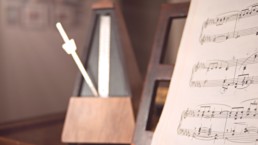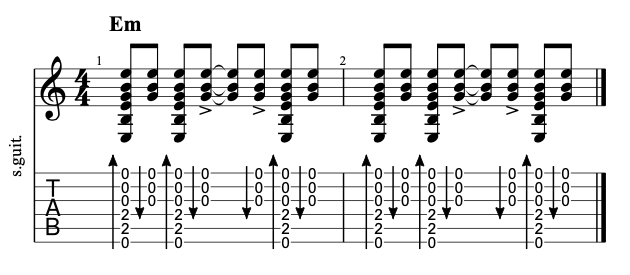Better Strumming: Don't Count, Feel

Strumming is a topic that doesn’t get nearly enough attention, given how many people struggle with it. Seems simple enough: swing the arm and hit the strings. But if you find it challenging to keep time and stay smooth, you already know there’s more to think about. It starts with feeling the pulse.
Let’s define “pulse” as a steady beat. Songs have a meter, which groups the pulses into twos and threes (and more). Playing in time really requires an awareness of three things at once: the steady pulse, the cycle of the meter, AND the actual beat of the song.
Keeping steady time isn’t hard. If you can walk (or breathe), your body knows what an even pace feels like.
There’s a physical feeling, a pulse, in the cadence of your steps. If you concentrate on it for a moment, you might notice that the sensation of your foot hitting the floor marks the beat exactly as a drum might.
Now moving that sensation to your hands, tap out four even beats with your dominant hand. Again, observe the feeling of arrival on the beat, and the sound that it creates. Then try alternating hands, leading first with the dominant hand and then the other. You’ve just established a basic 4/4 pulse as it’s often expressed in popular music. Tap with your foot on the downbeat and your hand on the second beat. This is a basic drum groove: thump, snap, thump, snap – usually expressed as kick, snare, kick, snare.
That back-and-forth creates a sense of forward motion that wasn’t there when we tapped even beats. Each beat is an arrival, but now we’re responding to the alternation of two different sounds. If the foot-hand move is tricky to coordinate at first, work with it slowly. It’s important to establish the difference in feel between the 1 and the 2, the foot and the answering hand.
Strumming alternates too, of course, as the arm moves up or down. But that takes us out of the larger context.
Instead of just pumping the arm, feel the downbeat as an arrival and the upstroke as a return to the starting point.
Here’s a simple back-and-forth eighth-note rhythm, indicated the way one often sees on internet chord charts:
D u D u D u D u
Of course, this format has obvious flaws in that it doesn’t indicate the timing, only the direction. Here, our timing is steady so things line up. But this is a much clearer way to express it:
Hold an E minor chord and play the pattern. Think of walking and the sensation of feet hitting the floor. If tapping your foot feels good, do it. If that’s tricky to coordinate, try nodding your head. It doesn’t matter how, but you want to feel that steady pulse with your body. Stay aware of the difference in sound, dynamic, and feel between a down and an up stroke.
Now strumming the pattern again, feel the rhythm in your fingertips, coming from the sensation and of the pick or finger striking the string. Just like your foot hitting the floor, there’s a moment of contact and a sense of arrival. That moment of contact is the intersection between the pulse and the rhythm, a location on the timeline.
Every strum pattern or variation you ever play will fit in with that timeline: the steady beat of the pulse overlaid with the cycle of the meter.
Swinging the arm creates a pair of subdivisions, or two eighth notes:
down-up down-up = 1 and 2 and
This is more than counting. That sense of arrival when foot hits floor or strum hits string is also the feeling of what we call the downbeat. Technically, a downbeat is the first count of the cycle, count 1. But for our purposes here, let’s say for now that the downbeat IS the physical sensation of the down stroke. So our simple back-and-forth strum can become a stomp.
We’ve also established the other half of the gesture, the return: the upbeat or offbeat, played with an up stroke. Upbeats have a feeling of their own; ever dance to a ska band? That pogo stick bounce is a natural response to the feeling of the music. Keeping that in mind, try this rhythm:
Note the accent on the “& of 2” and “& of 3” offbeats, played by two repeated upstrokes, and how it gives the strum a completely different feel.
Bottom line: any rhythm you might play has a physical sense to it somehow.
Does the rhythm thump, drive, dance, or lope? Different accent patterns create a different sense of motion. This is what the struggling strummer is missing: a sense of MOVING to the pulse. That movement provides the timeline, the reference, the way we match the strummed rhythm to the fundamental beat.
Our fundamental skill is the ability to coordinate movement of your strumming hand against the steady pulse in the body.
In other words, don’t count: feel. You can always slow down and map out the count as if you were measuring the beat with a ruler. But the math is meaningless without the motion.
JamPlay has over 450 guitar courses from 120+ instructors, and online guitar lessons tailored to every skill level, music genre, and playing style. Click here to learn more.
Dave Isaacs has established himself as a guitar teacher extraordinaire, having built a strong set of educational curriculums for beginner, intermediate, and advanced guitar players alike. Dave shares his expertise largely through video platforms, but also through his thoughtful writing. You can take guitar lessons from Dave Isaacs via his comprehensive video guitar courses on JamPlay.com.
Share this
Become a JamPlay member for unlimited access to 7000+ guitar lessons and 120+ artists and instructors. View membership plans ›






